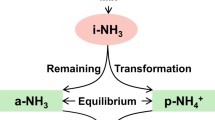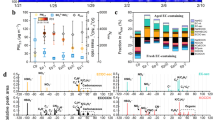Abstract
Estimates of the magnitude of biogenic sulphur emissions range from ∼70% of the total atmospheric sulphur burden1–7, and the chemical nature of the emissions has not been clearly established. Conway1 speculated that the principal volatile biogenic component of the sulphur cycle was hydrogen sulphide (H2S) whereas Lovelock et al.8 and Rasmussen9 have suggested that dimethyl sulphide (DMS) contributes to the apparent source deficits. Aneja et al.10 have shown that both H2S and DMS are emitted from saltmarshes. Other volatile sulphur compounds which may contribute to the sulphur burden of the atmosphere include methyl mercaptan (CH3SH)11,12, dimethyl disulphide ((CH3)2S2)11,12, carbonyl sulphide (COS)13 and carbon disulphide (CS2)14,15. We report here the discovery of CS2 and COS emanating from a saltmarsh and estimate their emission rates using emission flux reactor and bag chamber techniques. The species CS2 and COS are relatively inert in the troposphere, so may be assumed to penetrate to the stratosphere, where they may be photolysed to form the sulphur dioxide (SO2) and sulphates (SO42−) known to be present in the stratosphere. Based on the measured fluxes, we show that the emissions from marshes are important to the sulphate aerosol burden (≲19%) of the stratosphere, but not important for the tropospheric sulphur burden (≲0.2%).
This is a preview of subscription content, access via your institution
Access options
Subscribe to this journal
Receive 51 print issues and online access
$199.00 per year
only $3.90 per issue
Buy this article
- Purchase on Springer Link
- Instant access to full article PDF
Prices may be subject to local taxes which are calculated during checkout
Similar content being viewed by others
References
Conway, E. J. Proc. R. Ir. Acad. A 48, 119–159 (1943).
Eriksson, E. J. geophys. Res. 68, 4001–4008 (1963).
Junge, C. E. Air Chemistry and Radioactivity (Academic, New York, 1963).
Robinson, E. & Robbins, R. C. Sources, Abundance, and Fate of Gaseous Atmospheric Pollutants: SRI Project Report PR-6755 (American Petroleum Institute, New York, 1968).
Kellogg, W. W., Cadle, R. D., Allen, E. R., Lazrus, A. L. & Martell, E. A. Sciences 175, 587–596 (1972).
Friend, J. P. in Chemistry of the Lower Atmosphere (ed. Rasool, S. I.) 177–201 (Plenum, New York, 1973).
Granat, L., Hallberg, R. O. & Rodhe, H. Ecol. Bull (Stockholm) 22, 39–134 (1976).
Lovelock, J. E., Maggs, R. J. & Rasmussen, R. A. Nature 237, 452–3 (1972).
Rasmussen, R. A. Tellus 26, 254–260 (1974).
Aneja, V. P., Overton, J. H. Jr, Cupitt, L. T., Durham, J. L. & Wilson, W. E. Tellus 31, 174–178 (1979).
Aneja, V. P. thesis North Carolina State Univ. Raleigh (1975).
Hill, F. B., Aneja, V. P. & Felder, R. M. Envir. Sci. Hlth 13, 199–225 (1978).
Hanst, P. L., Spiller, L. L., Watts, D. M., Spence, J. W. & Miller, M. F. J. Air Pollut. Control Ass. 25, 1220–1226 (1975).
Sandalls, F. J. & Penkett, S. A. Atmos. Envir. 11, 197–199 (1977).
Lovelock, J. E. Nature 248, 625–626 (1974).
Crutzen, P. J. Geophys. Res. Lett. 3, 73–76 (1976).
Stevens, R. K., Mulik, J. D., O'Keefe, A. E. & Krost, K. J. Analyt. Chem. 43, 827 (1971).
Zimmerman, P. R. Testing of Hydrocarbon Emissions from Vegetation and Development of a Methodology for Estimating Emission Rates from Foliage (EPA Contract No. DU-77-C063, Research Triangle Park, 1978).
Seneca, E. D., Stroud, L. M., Blum, U. & Noggle, G. K. An Analysis of the Effects of the Brunswick Nuclear Power Plant on the Productivity of Spartina alterniflora (Smooth Cordgrass) in the Dutchman Creek, Oak Island, Snow's Marsh, and Waiden Creek Marshes, Brunswick County, North Carolina, 1975-1976 (Third Annual Report to Carolina Power and Light Company, Raleigh, 1976).
Woodwell, G. M., Rich, P. M. & Hall, C. A. S. A.E.C. Symp. Ser. 30, 221–240 (1973).
Junge, C. Proc. int. Conf. of Structure, Composition and General Circulation of the Upper and Lower Atmospheres and Possible Anthropogenic Perturbations (Melbourne, 1974).
Author information
Authors and Affiliations
Rights and permissions
About this article
Cite this article
Aneja, V., Overton, J., Cupitt, L. et al. Carbon disulphide and carbonyl sulphide from biogenic sources and their contributions to the global sulphur cycle. Nature 282, 493–496 (1979). https://doi.org/10.1038/282493a0
Received:
Accepted:
Published:
Issue Date:
DOI: https://doi.org/10.1038/282493a0
This article is cited by
-
Characteristics of turnover of carbonyl sulfide in four different soils
Journal of Atmospheric Chemistry (1996)
-
Blood concentrations of carbon disulphide in dithiocarbamate exposure and in the general population
International Archives of Occupational and Environmental Health (1993)
-
The disposal of flue gas desulphurisation waste: sulphur gas emissions and their control
Environmental Geochemistry and Health (1991)
-
The measurement of natural sulfur emissions from soils and vegetation: Three sites in the Eastern United States revisited
Journal of Atmospheric Chemistry (1987)
-
OCS, H2S, and CS2 fluxes from a salt water marsh
Journal of Atmospheric Chemistry (1986)
Comments
By submitting a comment you agree to abide by our Terms and Community Guidelines. If you find something abusive or that does not comply with our terms or guidelines please flag it as inappropriate.



